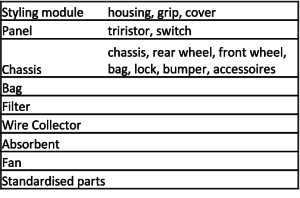
| Quelle | Erixon, Gunnar. „Modular function development, support for good product structure creation.“ DS 53: Proceedings of the 2nd WDK Workshop on Product Structuring 1996, Delft University of Technology, the Netherlands, 03.-04.06. 1996. 1996. |
|---|---|
| Einsatz | Ursprünglich für die Produktentwicklung gedacht, insbesondere zur Modularisierung einzelner Produkte, nicht ganzer Produktfamilien. Einsatz für Dienstleistungen möglich, wenn passende Kriterien für die Bewertung der Dienstleistungen eingeführt werden. |
| Idee | Bewertung des Produktes anhand der 12 entwickelten Kriterien:
Carry over = part of a product that can be re-used from an earlier to future product. Technology push = a part or a sub-system is likely to go through a technological shift during its life cycle, because customers’ demands will change radically. Product planning = change at a specific time Different specifications = access all variations to one or a few parts of the product and not let the variations spread throughout the entire product. Styling = possibility of altering the style of a product without causing disruptions in the whole product Common units = usually parts that contain the basic functions Process/Organization = similar types of operations can be placed in the same team work area Separate Testing = a module can be tested before it is supplied to the main flow, so that immediate feedback on quality can be received Black Box Engineering = possibility to purchase complete standard modules instead of individual parts. This reduces purchasing work and consequently less logistical (= less material to ship) and IT expenses (same computer system for specification). Service and maintenance = damaged module can be quickly replaced by the other, which leads to fast service. Upgrade = quick upgrade of the existing product or rebuilding the products for other purposes, which is useful for the sales team to give a correct price quickly. Recycling = number of different materials can be limited and environmentally hostel materials can be kept in the same module. |
| Phasen im Modularisierungsablauf | Strukturierung → Modulbildung → Testen (teilweise) |
| Modulstruktur | Komplexe Struktur |
| Input | Möglichst detaillierte Funktionale Dekomposition des Produktes/Dienstleistung |
| Output | Module, die auf qualitative Weise aus den Komponenten gebildet wurden. |
| Anwendungs- voraussetzung |
Schritt 1 Product Design Specification muss in Kooperation mit dem Design Team durchgeführt werden (Kenntnisse über den genauen Produktaufbau).
Im Schritt 2, wo es um funktionale Dekomposition des Systems geht, gibt es schon zahlreiche systematische Verfahren (s. unten). Allerdings wurden solche Verfahren für Produkte entwickelt, also deren Einsatz für Dienstleistungen muss noch geprüft werden: |
| Vorgehen |
|
| Fazit | Vorteile: Die Methodik ist leicht nachvollziehbar und kann deshalb uneingeschränkt eingesetzt werden. Die MDF ist zudem rein qualitativ, also keine Algorithmen nötig. Es wird eine Regel für die optimale Anzahl von Modulen vorgegeben. Nachteile: Die Module Drivers sind sehr speziell auf Produkte zugeschnitten und überschneiden sich zum Teil. Es müssen demnach neue Drivers bzw. Kriterien für die Dienstleistungen hineingezogen werden. Zudem wurden Schritte 1, 4 und 5 nicht ausführlich in der zugrunde liegenden Quelle erklärt. |


